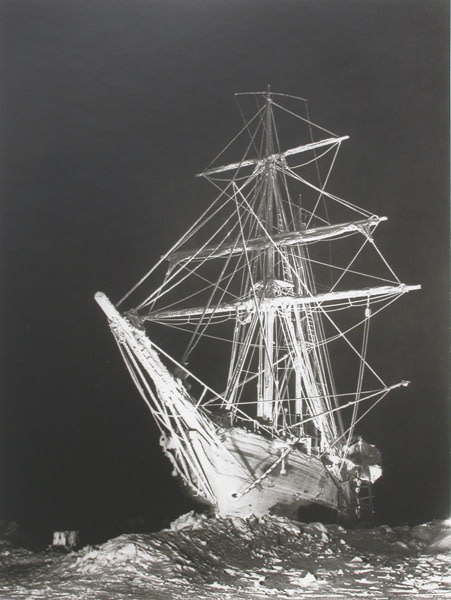Exhibition Dates: January 14 – February 11, 2006
Our annual thematic group exhibition, ANTARCTICA, explores this hostile region through the eyes of three photographers: Frank Hurley; Joan Myers and Herbert G. Ponting.
ANTARCTICA features some of the most well-known and enduring images of the Antarctic by 2 famous individuals: Herbert Ponting (1870-1935), the official photographer for Captain Robert Falcon Scott’s British Antarctic Expedition 1910-1913; and Frank Hurley (1885-1962), photographer for Ernest Shackleton’s expedition that started aboard the Endurance, which set sail from England in 1914. This exhibition features vintage photographs as well as limited-edition modern prints from the original negatives by the Royal Geographic Society, for whom we represent this work in Canada.
We also see this mythic landscape through the lens of Joan Myers (American, b. 1944) who spent four months photographing scientific study and daily life in the world's "most hostile continent", as a recipient of an Antarctic Artists and Writers Grant from the National Science Foundation's Office of Polar Programs in 2002. Myers spent October 2002 through January 2003 based at the McMurdo Station, an American research facility built in the 1950s. Her large-format colour photographs offer a spectacular modern-day view of Antarctica. Her work has been honoured by the Smithsonian Institute through its production of a solo exhibition titled “Wondrous Cold: An Antarctic Journey”, opening in Washington, D.C. in May 2006. It will then embark on a 15-venue national tour through the spring of 2010. A full-colour companion book complements this work and will be published by Harper Collins for release in February 2006.
Robert Falcon Scott (1868-1912) was an experienced naval officer who made his second journey to the Antarctic as the captain of the Terra Nova Expedition, which left New Zealand in 1910. Scott was defeated in his bid to be the first man to reach the South Pole by Roald Amundsen, a Norwegian explorer who arrived there a mere 30 days earlier. On his journey back from the Pole, Scott and his four expedition members succumbed to unusually brutal weather conditions for which they were ill-prepared. Herbert Ponting, an experienced photographer previously best-known for his images of the Russo-Japanese War, was selected by Scott to be his official photographer. Our exhibition includes vintage prints made by Ponting which depict life at base camp, as the cumbersome nature of photographic materials of the day restricted his activities to the first leg of this expedition.
Sir Ernest Shackleton (1874-1922) began his career under Robert Scott, but eventually became his competitor. In 1909, during his expedition aboard the Nimrod, Shackleton came within 97 miles of the South Pole, a feat for which he was later knighted. By the time the Endurance set sail on the British Trans-Antarctic Expedition of 1914, the South Pole had already been conquered by Amundsen; Shackleton’s ambitious goal was to cross the Antarctic continent on foot. However, their ship was besieged by ice, and had to be abandoned before they ever set foot on land. The Endurance was destroyed by ice, and Shackleton and his team spent six months adrift on an ice floe before reaching the relative safety of Elephant Island at the northern end of the Antarctic Peninsula. From this point, Shackleton, with a handful of his men, sailed on their largest surviving vessel, the James Caird, which they had dragged across the ice when they abandoned ship. After fifteen harrowing days at sea through terrible conditions, they reached the southern shore of South Georgia Island, which required them to traverse its central mountain range in order to reach civilization. Shackleton then set about mounting a rescue operation, returning to Elephant Island some four months after his departure and eventually rescuing all his men without the loss of a single life.
Frank Hurley, already a noted Australian photographer, accompanied the Endurance as expedition photographer and recorded the full remarkable story. This was his second trip to the Antarctic, having traveled with Sir Douglas Mawson on his 1911-14 Expedition to Commonwealth Bay. All told, it is estimated that he had made over 500 images by the time the Endurance was crushed. Seeing the imminent destruction of all his work trapped in the ship, he dove into the icy water to retrieve the glass-plate negatives. However, as the crew set out for their survival on foot, the weight of Hurley’s negatives and equipment exceeded what Shackleton allowed, and he was forced to choose a small number of negatives to be retained. In all, approximately 120 were kept; the rest Hurley smashed to pieces on the ice, so that he could never change his mind and go back for them. These negatives survived intact, and have been preserved in the collection of the Royal Geographical Society’s photographic archive. Recently, photographs from the original negatives have been offered as a limited-edition series for the first time.

